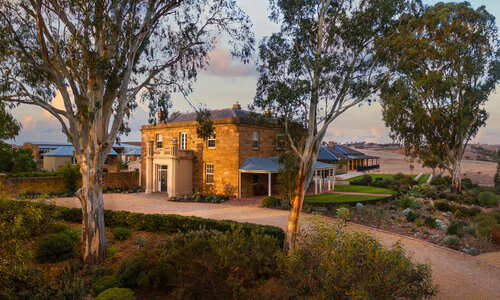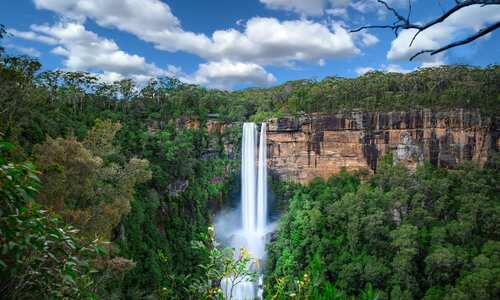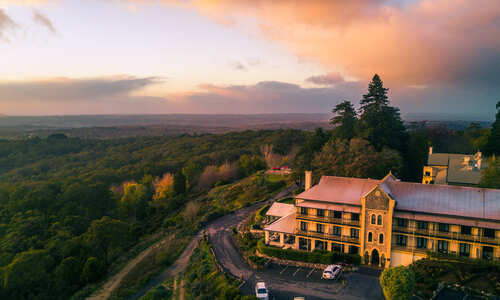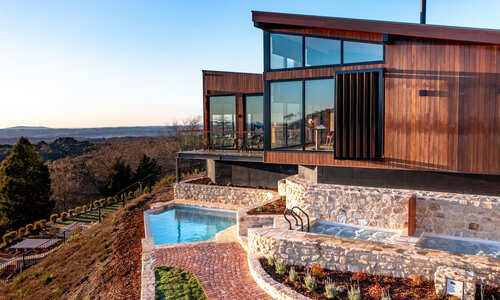Article content
22 May 2013 by Luke McCormick
David Warne explores Australia's Northern Territory.
The southern half of Australia's vast Northern Territory hosts Australia's most iconic landmark - Uluru, or Ayers Rock as white settlers came to know it. And yet a surprisingly high proportion of visitors to Australia don't make it to what is arguably the heart - and quite possibly the soul - of the country.
Despite several trips to Australia I was one of those very visitors not to have made it, so when the chance came to extend a recent journey to Australia I was delighted to add a few days in the Red Centre.
A significant proportion of visitors who do make it venture little further than the Uluru-Kata Tjuta National Park, so I was interested to spend a few extra days to see what else the Red Centre can offer visitors.

Accommodation options are relatively limited, and yet Ayers Rock resort manages to offer something for every budget.
For those who really want to splash out, Longitude 131° offers an extraordinary experience - with prices to match - but for most visitors Sails in the Desert is the accessible high-end accommodation option. The 5-star hotel (my base for 2 nights) recently underwent a full refurbishment. Bright and contemporary interiors inspired by Aboriginal designs now contrast with the rather functional exterior of the building. Rooms are spacious and well equipped, with all the essentials you would expect, including huge new flat screen TVs.
The new bar and dining area is particularly welcoming, with an open kitchen in the centre of the dining tables. A large central garden and pool area - partly shaded by the ‘sails' that give the resort its name - give the resort a feeling of space.
Quite apart from the refurbishment a lot else has changed in the past couple of years. For one thing, you are now likely to encounter far more Indigenous staff around the resort, as the Voyages group - part of the Indigenous Land Corporation - provides dedicated hospitality training and employment opportunities. A wider range of Indigenous experiences has also been introduced within the resort, including free daily shows and talks from Aboriginal artists and performers.

For most visitors the main reason to come is to see the imposing rock formations of Uluru and Kata Tjuta. Sunrise and sunset provide the best times for excursions and activities at both sites, virtually guaranteeing a riot of colour. There are several viewing spots to witness both monoliths to be illuminated or silhouetted by the rising or setting sun.
My first experience is the extraordinary ‘Tali Wiru', an exquisite dining-under-the-stars experience that starts with a champagne and canapés Uluru sunset, - an unexpectedly refined introduction to the Outback. A delicious four-course dinner of dishes that are subtly flavoured with native ingredients - ‘bush tucker' in other words - is served over a delightful couple of hours, paired with premium Australian wines. The evening concludes with a fascinating fireside talk from our aboriginal guide on the night sky.
The first of two early morning starts is a Kata Tjuta sunrise tour with breakfast, operated SEIT Outback Australia - an operator that seems to offer every conceivable day tour in the area.

Our small group arrives before the crowds to get the best spots on the viewing platform - perfectly located for sunrise on the 36 rock domes of the Olgas - at first light. The magic of the moment is slightly compromised by the arrival of some rather loud North Americans, but this can't detract from the spectacular, evolving colour-wash as the sun rises
A simple but tasty breakfast fortifies us for a gentle walk through Walpa Gorge (Walpa is the local name for the wind that whistles constantly between the rocks of the Olgas) and our guide reveals the history and legends of the site, which is sacred to the traditional landowners, the Anangu.
The sunrise tour merges seamlessly into a late morning bush tucker tour, also operated by SEIT. An informative walk through the bush with our Aboriginal host unveils the amazing variety of uses that Indigenous people have found for what appears to us to be the slim pickings of a desert landscape.

Lingering concerns about being coerced into eating writhing grubs soon pass, as our guide focuses on the growing commercial production of the fruits of the bush such as quondong and bush tomato. We taste various fruits in both raw and processed form (such as a delicious quandong and chilli jam), most of which can be bought in packets from Australian supermarkets. At first this seemed odd but it soon dawned on me that rather than degrading the sparse environment by picking fresh fruits for the daily tour this is actually a highly sustainable way of presenting the bush tucker experience.
After a brief lunch at the popular Gecko's Café in the centre of Ayers Rock resort we are back out into the bush again for our afternoon and sunset tour of Uluru.
Despite having seen countless pictures of Uluru - one of the most recognisable natural features on earth - I wasn't prepared for its sheer scale and presence. During our guided tour of the base we are introduced to the ‘Creation Stories' and shown rock art, along with sites where teaching of young Aboriginal people was - and still is - practiced. Spirituality seems to ooze from the very rock itself.

A short drive takes us to another viewing platform, where we are served sparkling wine and nibbles. The deep blue of the sky gives way to a riot of yellow, orange and red, silhouetting both Uluru and the distant Olgas.
The next morning's sunrise excursion was on camelback, with the award-winning Uluru Camel Tours. After a short briefing our camel train is soon weaving its way through the bush as dawn breaks. We enjoy views of both Uluru and Kata Tjuta - and yet another spectacular sunrise - during our hour-long ride.
For many visitors to the Red Centre two nights is the norm and the experience would end here. You can certainly cram in a lot into two days, as the various excursion operators coordinate their schedules with each other around the flight arrival and departure times.

However, my trip takes me on to Kings Canyon for the dramatic Rim Walk and then to Alice Springs, the unofficial ‘capital' of the Outback. En route we pass Mount Conner, the third huge red rock monolith of the region, which is sometimes mistaken for Uluru.
After a brief overnight stay in the extremely comfortable air conditioned tents at Kings Canyon Wilderness Lodge we leave early for the three-hour Kings Canyon Rim Walk, a popular circuit in the Watarrka National Park, located roughly mid-way between Ayers Rock and Alice Springs.
A moderate level of fitness is required for this walk, not least as the first 20 minutes are more or less straight up the steep canyon path. This is the toughest part of the walk but after that the circuit is relatively easy, with a clearly marked undulating track.

The scenery is hugely impressive, a giant's playground of red rocks, ravines and twisted trees. The appropriately named Garden of Eden at the half-way point offers a shaded stopping point offering the chance for a cooling swim. All around, huge white-barked gum trees, topped with rich green leaves, contrast against the red rock and blue skies, providing a haven for what sounds like thousands of birds.
A dusty and bumpy afternoon's drive on largely unsealed roads leads to Alice Springs. Fortunately, there are a couple of places to break the journey, including the remote outpost of Glen Helen Resort.
We arrive in Alice Springs in the early evening, for an overnight stay at the newly rebranded Hilton Doubletree (formerly the Crowne Plaza). Although a somewhat unremarkable hotel - as many city hotels are - it offers spacious, comfortable rooms, good facilities and the deservedly popular Hanuman pan-Asian restaurant, one of the best places in town to eat.

If ever a town evoked the spirit of the Outback it is Alice Springs. The modern town grew from a remote telegraph relay station to a thriving settlement of more than 25,000 inhabitants.
Of course, Indigenous people - notably the traditional land owners, the Arrernte - have lived in the area for thousands of years, and represent around 20% of the population today. Problems of petty crime and alcohol abuse, particularly among young unemployed Aboriginals, attract media attention but Alice Springs does seem to be tackling these issues with a range of community services to help Aboriginal citizens overcome the difficulties they face adapting to modern urban living.
A night out initially seems to confirm its frontier-town nature but with the same common-sense approach as you would take in any urban area at night there is little for visitors to fear. Indeed, as we move through backpacker bars and on to Lasseter's Hotel and Casino, with its large outdoor terrace, we see a very different side to the town, as smartly dressed revellers from the annual Alice Springs Cup horse race finish their evenings here.

The surprise is how much there is to see in and around the town. Even with just a morning for sightseeing I'm able to visit Simpsons Gap, the Telegraph Station Historical Reserve and ANZAC Hill, with its great views over the town and the MacDonnell Ranges beyond.
Simpson's Gap is a gorge in the MacDonnell ranges that makes a pleasant trip out of town, offering the chance see to resident black-footed rock wallabies.
The unexpectedly interesting Telegraph Station is now a museum to the construction of the Adelaide to Darwin telegraph line. The original buildings and telegraph equipment remain in a very pleasant park, located next to the ‘spring' - actually a misnomer - that gave the town its name.

I would have liked to visit the Royal Flying Doctor service, Alice Springs Desert Park and do one of the many scenic walks in the area - but like many visitors to the Northern Territory I haven't enough time.
Which, I suppose, is my parting thought: you can pack a lot into a short visit to the Red Centre but you will be rewarded if you allow a little longer to get under the skin of this beguiling region.
And consider the best time to visit. Europeans often visit the Red Centre during the hot summer months as part of wider travels around Australia, escaping the European winter. But as the locals will tell you, the region is best visited in winter (European summer), where you will be rewarded with clear blue skies, wonderful daytime temperatures and cool evenings.






